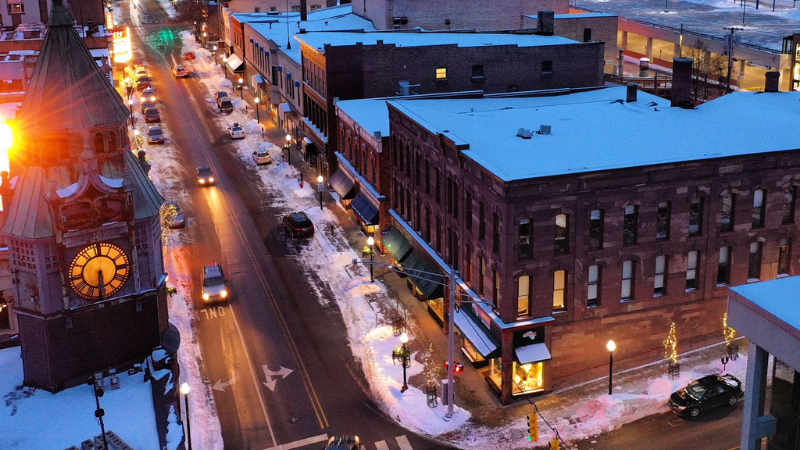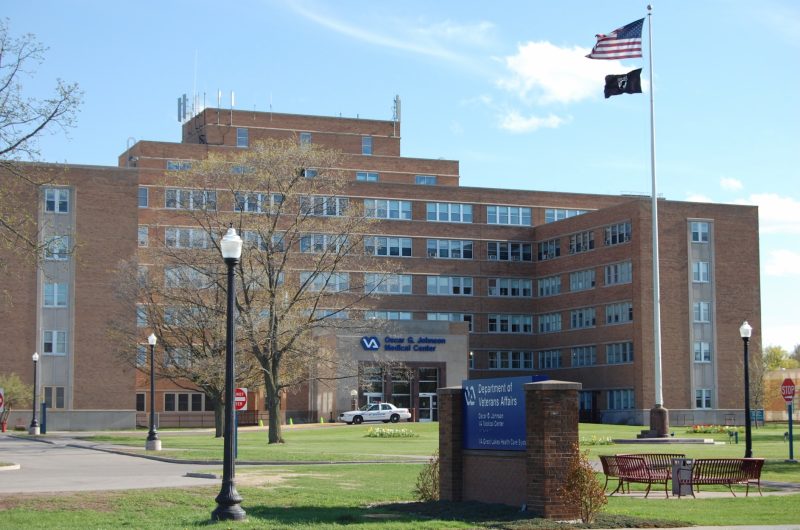Main Streets Across the Upper Peninsula: An Assessment

“Main Street” is a physical space and a symbol. It is a place where small business owners fight for survival against Corporate America’s big box stores and e-commerce giants.
Main Street also symbolizes an American past when life was slower, and is one of the country’s most cherished images. Walt Disney recognized the symbolic power of Main Street when “Main Street USA” was made the entrance to Disneyland in 1955.
As a physical space, Main Street serves many purposes, notably as a site for locally-owned retail. It is also the location for parades and festivals, providing a place where people come together for chance meetings.
In short, Main Street is an important symbol of American life and its condition is frequently used as a barometer of economic vitality. This article provides an assessment of Main Street economic conditions in four Upper Peninsula communities: Marquette, Sault Ste. Marie, Houghton, and Ironwood.
The field work for the project, undertaken in November 2021, assessed the number of street-level vacant properties, the number of in-progress storefront restorations, and the specific function of each business (government offices and residences were excluded from the survey).
Sault Ste. Marie (2020 population: 13,337) is situated at the Upper Peninsula’s eastern edge on the St. Mary’s river across from its namesake in Ontario, Canada. The city’s claim to fame, besides being a border crossing, is playing home to the Soo Locks that enable ships to navigate between Lake Superior and Lake Huron.
A total of five downtown blocks along Ashman and Portage streets were surveyed. Portage Street’s seasonal tourist businesses opposite the Soo Locks Park were not included, as they were closed. Services were the most important economic activity along the two main streets, followed by retailing and bars, restaurants and cafes (Table 1).
Marquette (2020 population: 20,629) is centrally located along Lake Superior’s southern shore and is the region’s largest city. It is a major service center with a state university, hospital, and large government presence.
Two blocks of south Front Street and five blocks along Washington Street (Marquette’s Main Street) were surveyed. Marquette has the strongest retail presence among the four cities devoting nearly half of its businesses to retail (Table 1). The number of gift shops and art galleries along Washington Street reflect the importance of tourism to the local economy. Restaurants and bars that cater to locals and visitors are also well represented in the downtown.
Houghton (2020 population: 8,386) is situated at the gateway to the Keweenaw Peninsula along the Portage channel that separates the Keweenaw from the ‘mainland.’ It is home to Michigan Technological University and serves as a regional service center.
A seven-block area of Shelden Avenue, Houghton’s main street, were surveyed (Table 1). Services, followed by retail shops, comprise the bulk of economic activities. Typical services include insurance agencies, real estate offices, barbershops and certified public accountants. Shelden Avenue also has a number of hotels and motels that cater to tourists and visitors to the nearby MTU campus.
Ironwood (2020 population: 5,045) is situated at the western edge of the UP, along the Wisconsin border, in a region whose population is declining. Its Main Street is about three-quarters of a mile south of US 2; the area’s major thoroughfare contains a number of highway oriented businesses including fast food establishments, motels and shopping plazas.
A five-block area along Aurora, the old Main Street, and Suffolk streets were surveyed. A small number of retail outlets maintain a foothold in the area, including furniture and craft stores, along with a number of bars and restaurants, but over a quarter of the properties are vacant (Table 1). The exterior condition of some of these structures suggests they have been vacant for some time.
Discussion
As a barometer of economic vitality, each Main Street offers a different reading. Ironwood’s Main Street is in the worst condition on the basis of the number of vacant properties.
The 2008 opening of a Walmart supercenter to the east of the city limits likely would have hurt Main Street retailers. The western UP’s falling population and Main Street’s location away from the heavily traveled US Route 2 suggests that attracting traditional retailers to the area is a challenge.
Houghton is unique among the four cities in that it has experienced sustained population growth over the past 20 years. A growing population has increased the demand for goods and services and led to commercial developments southwest of its downtown along MI 26. However, its Main Street contained no evidence of ongoing property renovations among its vacant storefronts.
In contrast, three of Marquette’s vacant Main Street properties are in the process of renovation. The former Nordic Theatre and bookstore on Washington Street is being converted into The Honorable Distillery, opening in 2022, while across the street a vacant store is undergoing renovation. Further west on Washington Street, a vacant restaurant is being renewed with a potential opening in December 2021. These private investments signal significant confidence in the city’s Main Street economic health.
Finally, although there was no evidence of new investment in Sault Ste. Marie’s Main Street, less than 10 percent of its properties were vacant, despite recent population losses in the city and surrounding county. This is attributable in part to the city’s participation in the state-funded Michigan Main Street program that utilizes the same economic development strategies associated with the National Main Street Center’s historic preservation program. At the same time, the presence of a hospital in the downtown has led physicians and a medical supplier to lease office space along Ashman and provided customers to downtown businesses.
These Main Streets attest to the contrasting fortunes of the UP’s cities. Marquette, with its strong retail presence and new investments, provides the most compelling image of a vibrant Main Street. Its success is linked to the multi-million dollar Founders Landing development occurring a few blocks away along the lakeshore. New housing, recreation facilities and a recently opened hotel promise more visitors and customers for Main Street businesses.
The other cities are less fortunate in that their Main Streets lack access to an amenity-rich brownfield site undergoing development. As the old property adage goes, “location, location, location!” For Marquette, Main Street’s proximity to a thriving waterfront development seems the key to its success.









Very interesting article . People are always wanting the Sault to be like traverse city or Marquette etc. not sure that will ever happen . We have a beautiful waterfront but no money to spruce it up.
No mention was made of the Soo Theater. There is a thriving community effort to restore the building and bring back live performances. Part of the theater effort is a strong opportunity for arts lessons — dance and other performance. As the theater grows it is encouraging other retail efforts downtown.
Very interesting analysis.
Well done and useful. What’s needed is a classification system that leads to discussion of economic potential (or lack of). Generally, a stable population concentration is the minimum basis for economic potential, with cities ( actually, better to view as regions) as the starting point.
Would be useful to evaluate critical factors and conditions specific to each of these four places. Conditions are specific to a place: For example: The Soo is at the terminus of major corridor, I-75, on a globally connected shipping route, and is an international entry. The significant Sioux Tribe of Chippewa presence is valuable. Houghton has none of these factors, yet is the most successful of the four places.
The greatest asset is intelligent, competent leadership and unified civic support. With that, much potential can be realized. Houghton/Hancock region paired with MTI demonstrate this The population data supports that contention. If Republicans succeed in killing the Biden Administration’s infrastructure plan, they will be killing the UP.
Thanks for the article.
Is the Soo maximizing cross-border marketing? To a lesser extent is Ironwood?
Houghton and Marquette could benefit most by encouraging young graduates to stay in area..building middle income condos/apartments on Main street or nearby. Partner with universities to develop tech hubs, municipal high speed internet.
Reversing de-population trend is key.
Re: the Zoo and crossing the border mentioned in this and other responses:
I thought the border was essentially closed for much of the pandemic?
Regardless, don’t you need a current passport to cross from the USA into Canada? Pre 9/11 a driver’s license would do IIRC?
Although the State Universities were mentioned in the Houghton and Marquette analysis, Lake Superior State College in the Sault was not mentioned. It not only serves Sault, Michigan, but also Sault , Ontario.